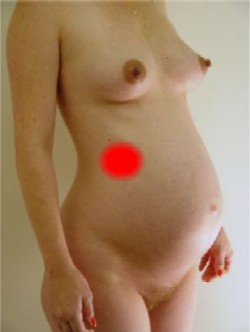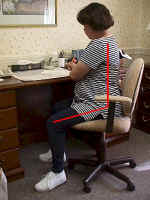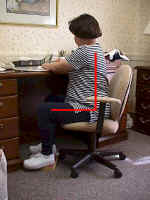Normal Pregnancy
Diagnosis of Pregnancy
Note to readers from
the Brookside Associates:
Although this page faithfully
reproduces the original Operational Medicine 2001, there is a
better (updated, with pictures) version of it in
Military Obstetrics & Gynecology. |
Pregnancy may be suspected in any sexually active woman, of childbearing age, whose
menstrual period is delayed, particularly if combined with symptoms of early pregnancy,
such as:
- Nausea (1st trimester)
- Breast and nipple tenderness (1st trimester)
- Marked fatigue (1st and 3rd trimesters)
- Urinary frequency (1st and 3rd trimesters)
- The patient thinks she's pregnant
Early signs of pregnancy may include:
- Blue discoloration of the cervix and vagina (Chadwick's sign)
- Softening of the cervix (Goodell's sign)
- Softening of the uterus (Ladin's sign and Hegar's sign)
- Darkening of the nipples
- Unexplained pelvic or abdominal mass
Pregnancy Tests
The diagnosis of pregnancy is accurately made with a urine pregnancy test. Current test
kits are highly specific and detect 35-30 mIU of HCG (human chorionic gonadotropin, the
pregnancy hormone) per ml of urine. In other words, the pregnancy test will be turning
from negative to positive at about the time of the first missed menstrual period.
In the event of an "equivocal" pregnancy test...one that is not
really positive nor negative, additional urine can be put through the test kit to boost
the sensitivity. Instead of using 3 drops of urine, you can use up to 6 drops of urine.
This will virtually double the sensitivity of the test, while increasing the chance of a
false positive by only a small amount.
In an urgent situation, if a patient is unable to provide urine for the test, serum can
be used in the urine test kit in place of urine.
- Draw blood into a test tube.
- Tape the test tube to the wall for about 10 minutes (allow it to clot).
- Using an eye dropper or a syringe with a needle, draw off a small amount of serum (the
clear, watery part of the blood that's left at the top of the test tube after the blood
has clotted).
- Use the serum instead of urine in the urine pregnancy test kit, drop for drop. If the
test kit calls for 4 drops of urine, use 4 drops of serum.
This is an imperfect solution, because the forms of HCG (pregnancy hormone) found in
serum are somewhat different from the forms found in urine. Further, the serum proteins
tend to sludge up the test kit, both mechanically and biochemically. That said, using
serum instead of urine will work well enough for most purposes in an operational setting
and can provide immediate insight into the patient's problem.
Prenatal Care
At the first prenatal visit, take a careful history, looking for factors that might
increase the risk for the pregnant woman. Many providers use a questionnaire, filled out
by the patient, as a starting point for this evaluation. A sample Prenatal Registration and Obstetrical Questionnaire
form can be used for this purpose.
One important aspect of prenatal care is education of the pregnant woman
about her pregnancy, danger signs, things she should do and things she should not do. Many
providers find it useful to give the woman printed material covering these issues that she
can take with her. This allows her to read the material at a later time and to refer to it
whenever she has questions. A sample Prenatal
Information form can be printed and used.
Routine visits:
- every 4 weeks until 28 weeks' gestation
- every 2-3 weeks until 36 weeks' gestation
- every week from 36 weeks to delivery
|
 |
|
5-Minute Pregnant Abdomen Exam
This video demonstrates the
complete abdominal exam, including estimation of fetal weight, calculation of
gestational age, and Leopold's Maneuvers.
www.brooksidepress.org |
At each prenatal visit:
Check weight
- Typical weight gain is about a pound a week. This means 30 to 40 pounds for the entire
pregnancy, although some physicians feel the ideal weight gain should be closer to 25
pounds. Weight gain is usually slow during the first 20 weeks. Then, there is usually
rapid weight gain from 20 to 32 weeks. After that, weight gain generally slows and there
may be little, if any weight gain during the last few weeks.
- If there is insufficient weight gain (below 13 pounds), there is concern that the baby
may not be getting enough food. If there is sudden weight gain (more than 2 pounds in a
week or more than 6 pounds in a month), this may be associated with the development of
fluid retention due to pre-eclampsia (toxemia of pregnancy).
Check blood pressure
- Blood pressure in early pregnancy will reflect pre-pregnancy levels. During the 2nd
trimester, maternal blood pressures usually fall below prepregnancy levels. During the 3rd
trimester, blood pressure usually goes back up to the pre-pregnancy level. Any sustained
BP of 140/90 or greater is considered significant and may indicate the development of pre-eclampsia.
Measure fundal height
- Use a tape measure to record the size of the uterus (technique
described below). The fundal height, measured in cm, should be approximately equal to
the weeks gestation, from mid-pregnancy until near term. Measurements falling within 1-3
cm of the expected value are considered normal. Fundal heights 4 cm different than
expected are considered abnormal and suggest the need for further investigation.
Listen for the heartbeat
- The normal rate is generally considered to be between 120 and 160 beats per minute. The
rates are typically higher (140-160) in early pregnancy, and lower (120-140) toward the
end of pregnancy. Past term, some normal fetal heart rates fall to 110 BPM. There is no
correlation between heart rate and the gender of the fetus.
Check for edema
- Swelling of the feet, ankles and hands is common during pregnancy. It can be
uncomfortable for the patient, but she can be reassured that it will go away after
delivery. Facial edema or any sudden increase in edema can be a sign of developing pre-eclampsia, so the BP should be checked.
- An effective treatment for edema is bedrest for 2-3 days, while drinking plenty of plain
water and avoiding excessive salt. This will mobilize the extracellular salt and fluids,
leading to a loss of several pounds through urination. In most cases, such treatment is
not necessary as the edema itself is not medically threatening.
Check protein and glucose
Ask about fetal activity
- Although fetal movement can be documented by ultrasound as early as 7-8 weeks of
pregnancy, fetal movement is not usually felt by the mother until the 16th week (for women
who have delivered a baby) to the 20th week (for women pregnant for the first time).
- Once they positively identify fetal movement, most women will acknowledge that they have
been feeling the baby move for a week or two, but didn't realize that the sensation
(fluttery movements) was from the baby.
- Movements generally increase in strength and frequency through pregnancy, particularly
at night, when the woman is at rest. At the end of pregnancy (36 weeks and beyond), there
is normally a slow change in movements, with fewer violent kicks and more rolling and
stretching fetal movements. A sudden decrease in fetal movement is a danger sign that
needs to be reported and investigated immediately.
- "Kick counts" are sometimes recommended to patients as a means of quantifying
fetal movement. One common way of doing a kick count is to ask the woman to count each
distinct fetal movement, starting from the time she awakens in the morning. When she
reaches 10 movements or kicks, she is done counting for the day. If she gets to 12 noon
and hasn't reached a count of 10 movements, she reports this to her provider and further
testing is done.
Any new symptoms
Nutrition
A pregnant woman should eat a normal, balanced diet for one person.
This may prove difficult, particularly during the early part of the pregnancy when she
may experience significant nausea.
It may also prove difficult later in pregnancy when she feels hungry all the time.
These women may find they do better by having more frequent (but smaller) meals, or snacks
between meals of relatively nutritious but low caloric foods.
Prenatal Vitamins
It is customary for pregnant women to take a prenatal
vitamin each day.
In theory, it might be possible for a pregnant woman to obtain the right amount of
essential vitamins and minerals through a careful and complete diet. In real life, it is
difficult for most women to achieve such a diet, particularly the need for Folate. It is
far simpler take a prenatal vitamin each day.
Those living in nutritionally-deprived areas will particularly benefit from the
addition of prenatal vitamins to their diet.
Laboratory Tests
Some routine lab tests are done on all pregnant women at different times during the
pregnancy. Other tests are done for a specific indication.
As early in pregnancy as feasible, obtain:
Subsequent lab tests consists of:
- Amniocentesis or CVS for women age 35 at 10-17
weeks
- Maternal serum AFP at 16-18 weeks
- Hemoglobin or hematocrit
at 28 weeks
- Serum glucose at 1-hour post 50g glucose load at 28
weeks
- Administration of Rhogam to Rh negative women
Other tests may be indicated, based on individual risk factors. These might include
screening for Sickle Cell disease (or
trait), thalassemia, G6PD, tuberculosis. Follow-up
tests may also be needed, based on the original screen. For example, a woman found to be
very anemic might be evaluated with serum folate
and ferritin levels. A woman failing her glucose
screening test will probably need a full glucose
tolerance test.
Ultrasound Scan
Routine ultrasound scanning of all pregnant women early in pregnancy is recommended by
some, but not all authorities in civilian settings.
For women in an operational environment, a routine ultrasound scan early in pregnancy
can be very useful, because it identifies those destined to miscarry, those with an
ectopic pregnancy, and those whose gestational age does not agree with their LMP.
Additional, medically-indicated ultrasound scans may also be appropriate. Ultrasound is
used to evaluate vaginal bleeding or pain, and discrepancies between the measured
size of the uterus and the expected size. It may be used to look for multiple gestations,
such as twins or triplets, determine the position of the fetus, and assess fetal growth.
Later in pregnancy, it may be used to evaluate fetal well-being, amniotic fluid volumes,
and to estimate fetal weight.
Estimating Gestational Age
The estimated delivery date is calculated by adding 280 days to the first day of the
last menstrual period. An alternative method of determining the due date is to add 7 days
to the LMP, subtract three months, and add one year. These calculations are made easier
with the use of a Gestational Age
Calculator.
One way to approximate a pregnancy's current gestational age is to use a tape measure to determine the distance from the pubic bone up over
the top of the uterus to the very top. That distance, measured in centimeters, is
approximately equal to the weeks of gestation, from about mid-pregnancy until nearly the
end of pregnancy. This is known as MacDonald's Rule.
If a tape measure is unavailable, these rough guidelines can be used:
- At 12 weeks, the uterus is just barely palpable above the pubic bone, using only an
abdominal hand.
- At 16 weeks, the top of the uterus is 1/2 way between the pubic bone and the umbilicus.
- At 20-22 weeks, the top of the uterus is right at the umbilicus.
- At full term, the top of the uterus is at the level of the ribs. (xyphoid process).
Ultrasound can be used to determine gestational age. Measurement of a crown-rump length
during the first trimester (1-13 weeks) will give a gestational age that is usually
accurate to within 3 days of the actual due date. During the second trimester (14-28
weeks), measurement of the biparietal diameter will accurately predict the due date within
10-14 days in most cases. In the third trimester, the accuracy of ultrasound in predicting
the due date is less, with a plus or minus confidence range of as much as 3 weeks. A chart
showing different ultrasound measurements at different gestational ages in shown in the Ultrasound Gestational Age Measurements
chart.
Fetal Heart Beat
Although the fetal heart begins beating as early as the 5th week after the LMP, your
ability to detect it will be limited by your equipment.
An ultrasound machine usually will see a heartbeat by 5 to 6 weeks gestation if
equipped with a vaginal probe. Abdominal ultrasound will usually see the heartbeat by the
7th-8th week of pregnancy.
If you use a Doppler ultrasound fetal heartbeat detector, you can, with effort, usually
hear the heartbeat by 12-14 weeks gestation and routinely after that.
Using a DeLee stethoscope (equipped with a head-mount), you can sometimes hear the
heartbeat by 16 weeks but unless you are practiced with it, you won't hear it until 20
weeks, at which time the mother can usually tell you that she feels the baby moving.
Using a conventional stethoscope, you may never hear the fetal heartbeat.
Disability
Pregnancy causes many changes in women, not the least of which are change in weight and
its' distribution, balance and increased vulnerability of ligaments and joints to stress.
Because of these changes, the safe care of pregnant women requires that their normal work
activities be modified. In the Navy, OPNAVINST 6000.1A is the instruction which provides
the greatest detail of guidance for the administrative aspects of managing this
disability. In the Marine Corps, MCO 5000.12d gives equivalent guidance.
Maternal Skin Changes
Over time, there is a darkening of the maternal skin, in predictable ways.
- Chloasma is a darkening of the facial skin, after the 16th week of pregnancy,
particularly in women with darker complexions and significant exposure to the sun.. After
delivery, the skin clears, but for some individuals, a persistent darkening of the skin
remains.
- Spider telangiectasias are small, bright red, star-shaped skin discolorations that
blanch with direct compression and then return as soon as the compression is released.
After delivery, they will largely resolve, but some may remain.
- Stretch marks occur primarily in late pregnancy and are due to a separation of the
underlying collagen tissue. They are dark red. After delivery, they will gradually
lighten, ultimately healing as fine, faint, silvery-gray lines. Who gets them and how
severe they are is dependent on the genetic predisposition of the mother and the degree of
mechanical stress placed on the skin. There are no scientifically-established methods to
either prevent them or treat them. However, generations of women have applied cocoa butter
to the skin in the belief that it is helpful.
- A "linea nigra" is a dark line running from the pubic bone up the center of
the abdomen to the ribs. This appears late in pregnancy and is due to a combination of
increasing concentration of melanocytes (skin cells capable of darkening) in that area,
plus the high levels of melanocyte stimulating hormone produced by the placenta.
Exercise in Pregnancy
If the pregnancy is normal, moderate amounts of exercise are acceptable and desirable.
Some restrictions are appropriate:
1. Women should not start a new sport or exercise while pregnant, but may continue
previous activities.
2. Activities which require a fine sense of balance to preserve the woman's personal
safety (horseback riding, downhill skiing, etc.) are inadvisable because pregnant
women are inherently and unavoidably unstable in their balance.
3. Because of pregnancy-induced changes in the supporting cartilage and ligaments
(softening), the joints are relatively unstable. Thus, activities which place great stress
on any joints are unwise.
Nausea & Vomiting
These are common during pregnancy but may be aggravated by strong smells (food,
garbage, machine oil, etc.) and motion. Symptoms appear quite early and are usually mild,
requiring no treatment, disappearing by the 16th week or sooner. Occasionally, these
symptoms are severe and require intervention.
If a pregnant woman states, "I can't keep anything down," and has ketones in
her urine, she must be re-hydrated with crystalloid such as 5% dextrose in lactated
Ringer's solution (D5LR). One liter is given in a short time (15-20 minutes), and the
second liter given over an hour or two. Sometimes a third liter, given over several hours,
will be necessary. While this rate of hydration would be much too fast for an older
individual with heart disease, the cardiovascular system of a young, healthy, pregnant
woman is very "stretchy" and will tolerate such rapid infusions well.
After IV therapy, the woman is generally feeling much better and can return to her
duties. If this rehydration is insufficient to suppress her symptoms, then a more
prolonged course of therapy is recommended.
Try to avoid antiemetics in the pregnant patient as the long-term consequences of most
of the drugs on a developing pregnancy are not well established. Nonetheless, the
long-term results of protracted vomiting, dehydration, electrolyte imbalance and ketosis
are known and unfavorable to the pregnancy, so if it appears that IV hydration alone is
not controlling the symptoms, move to antiemetics with dispatch.
Conventional doses of Antihistamines (Benadryl),
Anticholinergics (Scopolamine), Compazine, Phenergan,
and others have all been used to good advantage in these situations.
Heartburn
This common pregnancy-related ailment is caused by leaking of stomach acid into an
unprotected esophagus, causing a chemical burn known as heartburn. The best relief is
obtained by sucking on an antacid tablet until the pain goes away (one or two tablets).
Chewing and swallowing the tablets will also be effective but usually requires more
tablets. If antacids are not available, eating or drinking anything will give some relief
as it will partially buffer the acid in the esophagus and rinse it back down into the
stomach.
Pepcid AC can also be used safely during
pregnancy.
Sciatica
Sciatica occurs in 30% of pregnant women and is characterized by sharp pains in the hip
and buttock on one or both sides, shooting down the back of the thigh. There may also be
numbness of the anterior thigh on the effected side. This is due to compression of the
sciatic nerve as it exits the spinal column in the small of the back. It is provoked by
pregnancy and disappears after delivery.
Treatment of sciatica:
- Avoid standing for long periods of time.
- When sleeping, assume a semi-fetal position, with both knees drawn up and a pillow
placed between the knees.
- When sitting, make sure the knees are slightly flexed so that the knees are at least
level with the hips or slightly higher than the hips.


|
Sleeping with one leg straight and the other knee drawn up is a bad position as far as
the back is concerned. Torsion is placed on the lower spine, aggravating any pressure on
the sciatic nerve that may be present.
Sleeping on the side while pregnant is a good, idea, but both knees should be
drawn up (flexing the thighs). Either side will work well.
In order to maintain this semi-fetal position comfortably, it is necessary to place a
small pillow, folded blanket or towel between the patient's knees. This will absorb
moisture, separate the legs, minimizing skin-to-skin contact, and provide additional
support to the legs. With practice, this position will become very comfortable.
|


|
When sitting at a desk, posture is very important.
This picture illustrates two problems:
- The chair is too high, resulting in her knees being lower than her hips.
- She is not sitting straight toward the desk. This position places torsion on the lower
back, aggravating her sciatica problem.
The lower picture has corrected one of the two problems.
- She has lowered her chair and put a Chicago phone book underneath her feet, elevating
them. This results in her knees being level with her hips, rocking her pelvis backwards
and straightening out the lower spine. This will ease pressure on the sciatic nerve.
- She has not turned to face the desk squarely. That would have solved the second problem.
|
Carpal Tunnel Syndrome
Approximately 30% of pregnant women will develop numbness in one or both hands
following the distribution of the median nerve. (index finger, middle finger, medial
surface of ring finger, with sparing of the lateral surface of the ring finger and the
little finger).
 |
This is due to swelling and compression of the median nerve as it passes through the
"carpal tunnel" in the wrist.
The dominant hand is more frequently effected. It is usually worse in the morning and
improved in the evening. After delivery, the condition goes away gradually.
No treatment is necessary for this condition, so long as the motor portion of the nerve
is still functioning normally. When treatment is necessary, splinting the wrist in a
"cockup splint" will be helpful. Injection of the carpal tunnel with steroids
may also be done (after 24 weeks of pregnancy).
Rarely, surgery may be necessary to free up the median nerve, although this is almost
never required during pregnancy.
|
Upper Respiratory Infections
Most pregnant women will have at least one URI while pregnant.
Drugs are to be avoided, but the following medications may be used to good advantage if
necessary:
Acetaminophen
|
This
will effectively relieve muscle aches and fever. It is considered safe during pregnancy.
(Category B drug, the same as prenatal vitamins.) |
Guaifenesin
|
This
expectorant is considered safe during pregnancy. |
Pseudoephedrine
|
This
sympathomimetic is a very effective decongestant. It's use during the 1st trimester is
sometimes restricted because of indirect data suggesting a slight increased risk of fetal
malformations. Late in the third trimester, its' use is again restricted because of its'
somewhat unpredictable cardiovascular effects. |
Triprolidine
|
An
effective antihistamine, it is considered safe during pregnancy. |
|
Antibiotics during Pregnancy
Because of various infections, the need to place pregnant women on
antibiotics may arise. While this listing is necessarily incomplete due to space
considerations, it will give you a guide to selecting antibiotics for these women.
Penicillins
|
Safe during pregnancy. |
Cephalosporins
|
Safe during pregnancy. |
Erythromycin
|
Safe during pregnancy. |
Azithromycin
|
Safe during pregnancy. |
Tetracycline(incl. doxy)
|
UNSAFE AT ANY TIME DURING PREGNANCY. |
Metronidazole
|
Safe after 14 weeks. Avoid single-dose therapy.
Safety prior to 14 weeks not well-established. |
Aminoglycosides
|
Basically safe during pregnancy, but renal and
ototoxicity are potential problems if the dose is high or prolonged. |
Clindamycin
|
Safe during pregnancy. |
Chloramphenicol
|
Probably safe prior to 28 weeks |
Sulfa drugs
|
Safe prior to 34 weeks. After that, babies may
develop jaundice if exposed to sulfa. |
Quinine
|
Only to be used in life-threatening,
chloroquine-resistant P. Falciparum infections |
Miconazole
|
Safe during pregnancy. |
Clotrimazole
|
Safe during pregnancy. |
Quinacrine
|
Probably safe during pregnancy. |
Chloroquine
|
With prolonged or high doses may cause
congenital defects. |
Pyrimethamine
|
Safe after 1st trimester. Add folic acid
supplement. |
Trimethoprim
|
Safe after 1st trimester. Add folic acid
supplement. |
Primaquine
|
May cause hemolytic anemia in the presence of
G6PD deficiency. You may use it if needed. |
Other Drugs during Pregnancy
Local anesthetics (Xylocaine) may be used with
safety, although the addition of epinephrine to
them is problematic. Epinephrine may have
unpredictable effects on the maternal cardiovascular system (and hence the blood flow to
the baby), so epinephrine is generally to be
avoided.
Aspirin should not be taken as it may lead to
significant fetal hemorrhage.
Codeine, Demerol,
Morphine and other narcotics may be used as needed
at any stage of pregnancy, but the addictive potential should be recognized. Other than
the risk of fetal drug withdrawal syndrome, these major pain relievers are considered safe
for use during pregnancy.
Immunization during Pregnancy
Tetanus Booster
|
Safe during pregnancy. |
Diphtheria Toxoid
|
Safe during pregnancy. |
Hepatitis B vaccine
|
May be safely given to pregnant women who are at
high risk of exposure. |
Influenza or pneumococcal immunization
|
May be given to pregnant women if they are at
increased risk of these conditions. |
Measles, mumps and rubella vaccine
|
Do not give to a woman while pregnant but defer
until after the pregnancy. |
Yellow Fever
|
Can and should be given to pregnant women
traveling to areas where Yellow Fever endemic. |
Polio
|
Can and should be given to pregnant women
traveling to areas where polio is endemic. |
Anthrax Immunization
|
Do not administer during pregnancy. |
Immune globulin
|
May be given any time it is clinically
indicated. |
Thermal Stress
Fetal enzyme systems may not function properly if subjected to unusually high
temperatures. In laboratory animals, elevation of core temperature is associated with
fetal losses. For this reason, pregnant women are generally restricted from saunas and
Jacuzzis.
The important thing to avoid is elevation of the core temperature. Any activity which
may lead to an elevation of core temperature should be restricted. This would include
sedentary exposure to high ambient temperatures which would otherwise be tolerated by a
non-pregnant person, or moderate exercise in moderately-elevated temperatures.
Aboard warships, high ambient temperatures are often found in the:
- Engine spaces
- Laundry
- Mess decks
Noise
Pregnant women should wear hearing protection when exposed to ambient
noise levels above 84dBA, including infrequent impact noise. (So should non-pregnant women
and men.)
Brief exposure (5 minutes per hour or less) of hearing-protected pregnant
women to ambient noise above 84dBA in order to transit high noise areas is probably safe.
Prolonged exposure to this level of noise is not recommended.
Pregnant women should avoid any exposure to ambient noise greater than
104dBA (corresponding to the need for double hearing protection), unless absolutely
essential for quickly moving through a high noise area. The abdominal wall muffles
(attenuates) the noise only somewhat and these very noisy areas may pose significant
problems for the developing fetus.
Low-Frequency Whole Body Vibration
This is the type of shaking vibration one might experience if operating a jackhammer or
driving at high speed over a highway with many potholes. It is to be avoided during
pregnancy.
Chemical Solvents
Organic solvents, such as turpentine, fuel, oils, lubricants, and paint thinner may
have adverse effects on a developing fetus.
The greatest risk comes from ingestion of these solvents, or by chemical spills with
contamination of the skin. Inhalation, though less likely to delivery significant
quantities of the material, should also be avoided.
Heavy Metals
It is very important to avoid maternal exposure to lead, cadmium and mercury.
X-rays during Pregnancy
All things being equal (which they never are), it is better to avoid x-rays while
pregnant.
If indicated, (chronic cough, possible fracture, etc.), then x-rays are acceptable.
If you need an x-ray for a pregnant patient, go ahead and get it, but try to shield the
baby with a lead apron to minimize the fetal exposure.
In your zeal to shield the pregnant abdomen, be careful not to shield so much that the
value of the x-ray is diminished. If the shielding is too high while obtaining a chest
x-ray, you will have to obtain a second x-ray to visualize the area shielded during the
first x-ray.
Radiation exposure during Pregnancy
There appears to be a threshold for fetal malformation or death of at least 10 Rads,
below which, biologic effects cannot be demonstrated. Allowing for a 10-fold margin of
safety, it does not appear that any exposure below 1 Rad will have any harmful effects.
It would take about a thousand chest x-rays to deliver this amount of radiation to the
unshielded maternal pelvis.
At the same time, our knowledge of the biologic effects or radiation may be incomplete,
so it is better for pregnant women, as a rule, to avoid any unnecessary exposure to
ionizing radiation, and to use appropriate shielding when it is necessary.
CRT Use and Pregnancy
There is no good evidence that working in front of a CRT (Cathode Ray Tube) poses any
threat for the pregnant woman, either from electromagnetic radiation (EMR) or from
eyestrain.
Ergonomics are important for all sitting personnel, and particularly pregnant women.
Good low back support, correct height for the CRT, wrist support and proper positioning of
the legs (with the thighs flexed slightly so the knees are at least level with the hips,
if not slightly higher than the hips), will contribute to the comfort and performance of
these personnel.
Diving while Pregnant
Simply stated, pregnant women should not dive. It poses health risks to themselves and
their fetus.
Pregnant women have increased amounts of body fat and 3rd-space fluid retention, each
of which tends to trap nitrogen and other gasses due to poor circulation through those
areas. This predisposes them to decompression sickness and air embolism.
While fetuses do not form gas bubbles more easily than women, even a few bubbles are
likely to be very dangerous to the fetus because of fetal circulation. In adults, bubbles
tend to be filtered by the pulmonary circulation through the lungs, but in fetuses, there
is a bypass of the lung circulation through the foramen ovale and ductus arteriosus. This
means that bubbles will not be filtered but may instead go directly to the brain or
coronary vessels, possibly causing stroke or death.
There is also evidence that diving may produce birth defects, including limb
reductions, cardiac malformations, and other problems, although this area has not been
carefully researched.
Hyperbaric treatment
The effects of controlled hyperbarism on pregnant women and fetal development are
uncertain.
In eastern Europe, scientists using relatively low pressures but repeatedly and for
long periods of time have reported no particular problems with it. One study suggests that
while in a hyperbaric atmosphere, the fetus changes its' circulatory flow in the direction
of neonatal flow patterns (with narrowed or closed ductus arteriosus and foramen ovale).
Upon return to normal barostatus, the flow again reverses to the normal fetal flow
pattern. Whether this change poses any long-term problems for the fetus is unknown.
Based on these concerns, it is inadvisable to allow any pregnant woman to dive or enter
a hyperbaric chamber unless strongly indicated for medical reasons. If an accident occurs
in which it would be desirable to place the pregnant woman in a hyperbaric chamber, the
risks to the fetus (mainly theoretical) must be balanced against the risks to the mother
of not undergoing hyperbaric treatment.
Pregnant Aircrew Members
Aircrew status while pregnant is a complex issue, involving fetal risks, maternal risks
and aircrew performance.
The maternal risks include decreased balance, decreased motion tolerance, decreased
g-tolerance, gas compression/recompression effects. During the second and third trimester,
placental abruption caused by the shearing force of inadvertently falling or striking the
abdomen violently is a relatively common occurrence.
Fetal risks include exposure to noise, heat, chemicals, organic solvents, and
low-frequency, whole-body vibration.
For these reasons, there is general agreement among the services to restrict pregnant
aircrewman from participating in high-performance aircraft flights. There is less
agreement in the area of helicopters and multiengine, fixed-wing aircraft.
Whether to allow a pregnant aircrewmember to continue her flight duties should be
individualized, after considering the stage of pregnancy, the presence or absence of risk
factors for her pregnancy or her flight crew performance, her individual service's rules,
the degree of exposure to potentially harmful stressors in the aviation environment.
Home
|








